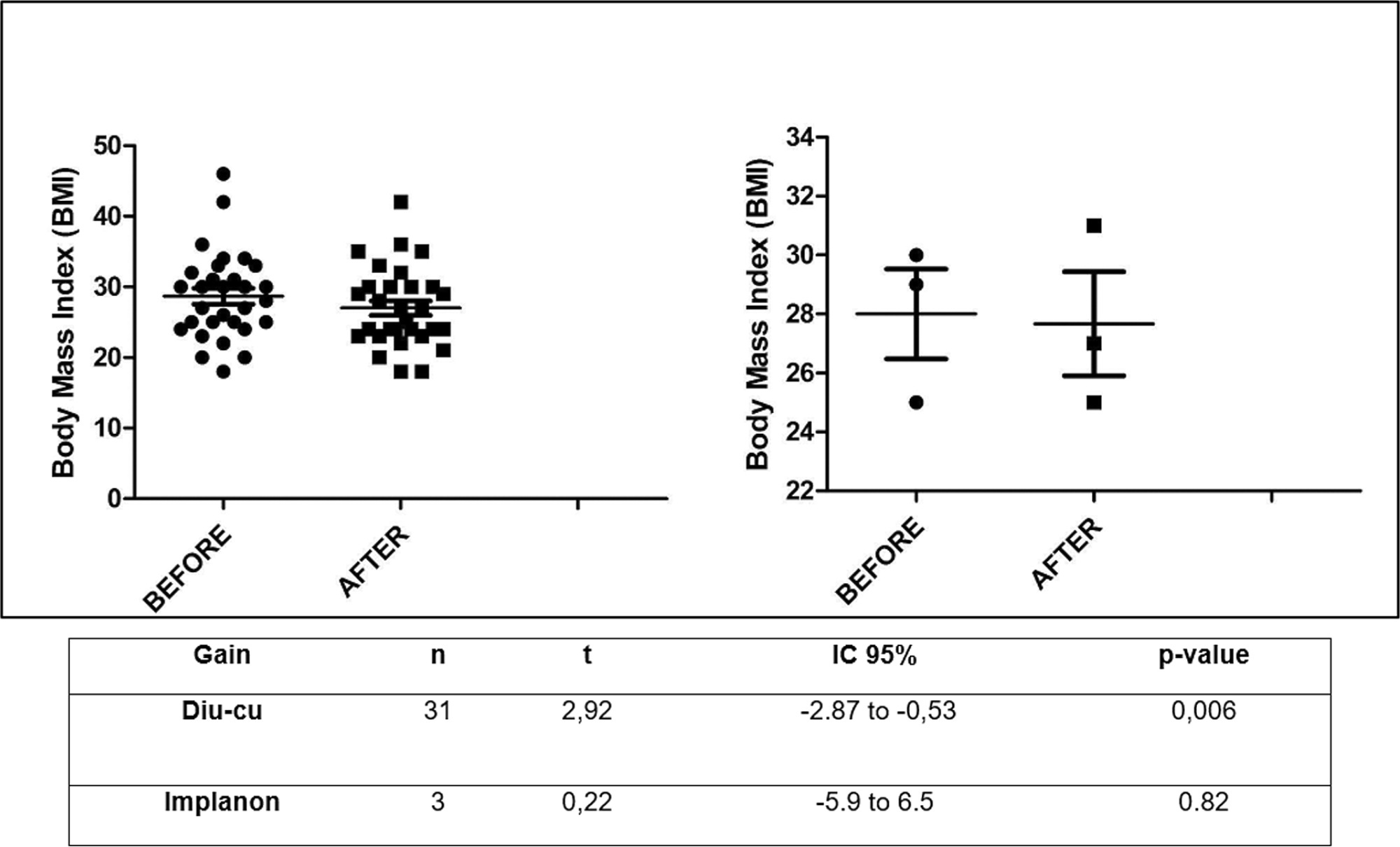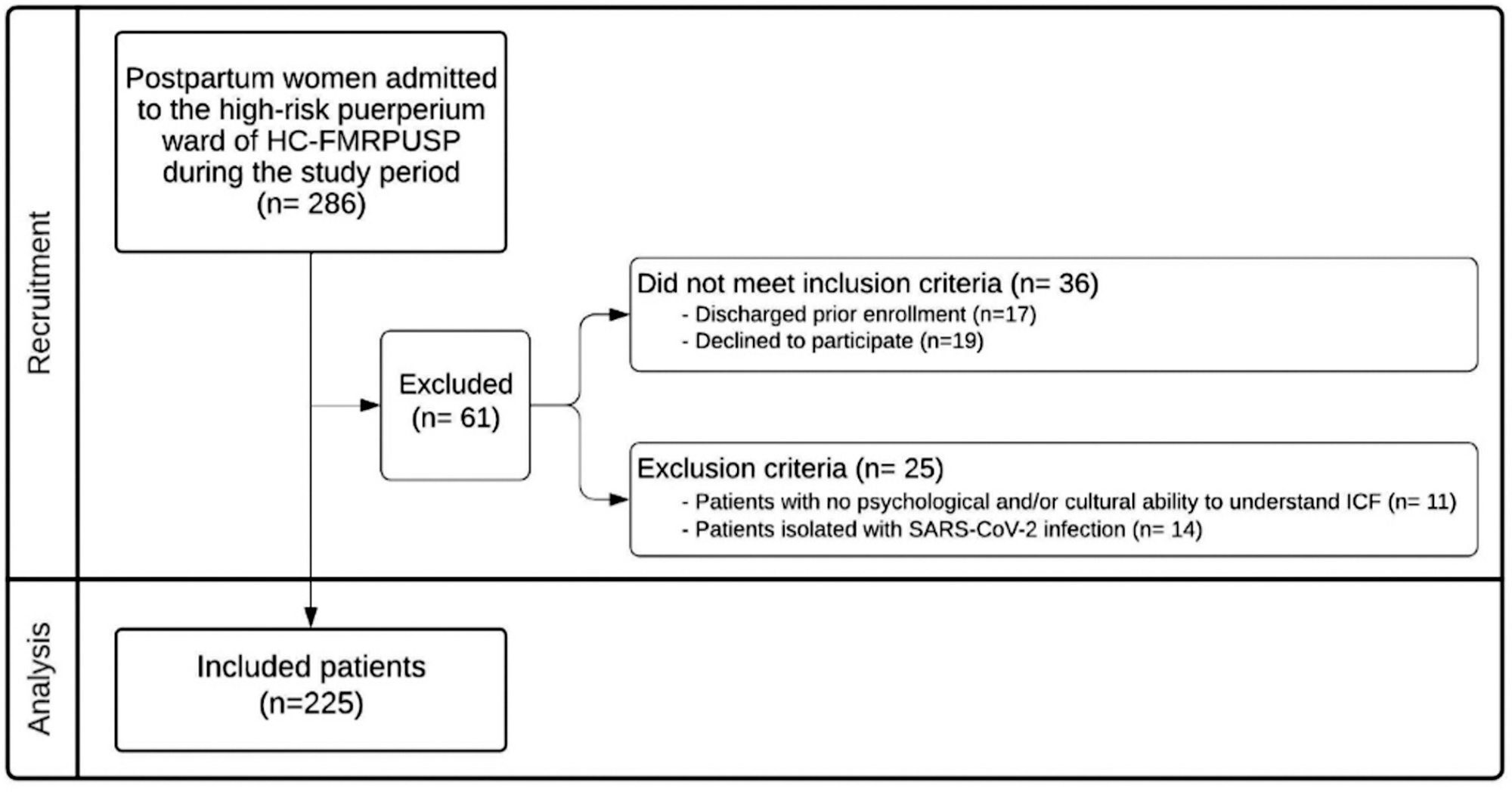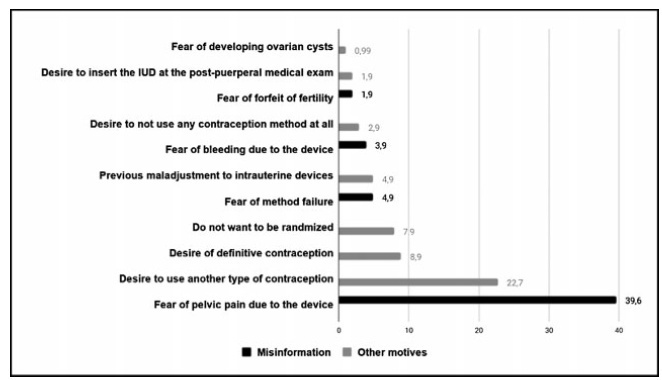Summary
Revista Brasileira de Ginecologia e Obstetrícia. 2023;45(8):456-464
Evaluate the different perspectives that involve the choice of long-acting reversible contraceptives (LARCs), the issues related to this process and the consequences of deciding one method in the women's in the primary health care (PHC) center in Sousas, a district in Campinas, SP (Brazil).
This is an analytical cross-sectional study, it was performed at the PHC in Sousas. Data were collected through the analysis of medical records and interviews with women who live in Sousas and had the insertion of the copper intrauterine device (IUD) (D) from April 2021 to April 2022 or the etonogestrel implant (I) from May to December 2022. The study was approved by the Research Ethics Committee of the Medical Science School at the State University of Campinas (UNICAMP).
Reason for choosing this LARC: medical (D: 52%; I: 100%), easy adhesion (D: 71%; I: 67%), effectiveness (D: 55%; I: 100%). Indication by health professionals (D: 65%; I: 100%). And improvement of clinical characteristics: mood (D: 77%; I: 67%), body mass index (BMI; D: 52%; I: 33%), and libido (D: 84%; I: 67%).
It is suggested that women tend to decide between LARCs when guided by their doctor or PHC health professionals, and they select LARCs because of the ease of use and low failure rates. Therefore, this study highlights how LARCs can positively interfere in the aspects that pervade contraception, such as BMI, libido, and mood.

Summary
Revista Brasileira de Ginecologia e Obstetrícia. 2023;45(2):059-064
To evaluate the seroprevalence of toxoplasmosis among puerperal women cared for at a tertiary university hospital and the level of understanding of these puerperal women about toxoplasmosis, vertical transmission, and its prophylaxis.
For this cross-sectional study, we evaluated 225 patients using presential interviews, prenatal documentation, and electronic medical records. Data were stored using Research Electronic Data Capture (REDCap) software. Prevalence rates were estimated by the presence of reactive IgG antibodies against Toxoplasma gondii. Data analysis was performed using the chi-square test and calculation of the odds ratio (OR). Seroreactivity to T. gondii and exposure variables (age, educational level, and parity) were analyzed using a confidence interval (95%CI) and a significance level of 5% (p < 0.05).
The seropositivity rate for T. gondii was 40%. There was no association between seroprevalence and age. Primiparity was a protective factor against seropositivity and low education was a risk factor.
Knowledge of T. gondii infection and its transmission forms was significantly limited, presenting a risk for acute maternal toxoplasmosis and vertical transmission of this protozoan. Increasing the education level regarding the risk of toxoplasmosis during pregnancy could reduce the rates of infection and vertical transmission of this parasite.

Summary
Revista Brasileira de Ginecologia e Obstetrícia. 2021;43(3):172-177
To evaluate the acceptability of postplacental placement of intrauterine devices (PPIUD), reasons for refusal and suggested policies to increase its use.
Cross-sectional study conducted at the Women Hospital of the Universidade de Campinas, Campinas, SP, Brazil. Postplacental placement of intrauterine devices was offered to women admitted in labor who did not present infections, uterinemalformation, twin pregnancy, preterm birth, and were at least 18 years old. In case of refusal, the parturient was asked to give their reasons and the answers were classified as misinformation about contraception or other reasons. The following were considered misinformation: fear of pain, bleeding, contraception failure and future infertility. Bivariate analysis was performed.
Amongst 241 invited women, the refusal rate was of 41.9%. Misinformation corresponded to 50.5% of all refusals, and the reasons were: fear of pain (39.9%); fear of contraception failure (4.9%); fear of bleeding (3.9%); fear of future infertility (1.9%); other reasons for refusal were 49.5%. Parturients aged between 18 and 27 years old refused the PPIUD more frequently due to misinformation (67.4%), and older parturients (between 28 and 43 years old) refused frequently due to other reasons (63.6%) (p=0.002). Themean age of those who declined the PPIUD due to misinformation was 27.3 ± 6.4 years old, while those who declined for other reasons had a mean age of 29.9 ± 5.9 years old (p=0.017).
The refusal of the PPIUD was high, especially amongst young women and due to misinformation. It is necessary to develop educative measures during antenatal care to counsel women about contraception, reproductive health and consequences of unintended pregnancy.

Summary
Revista Brasileira de Ginecologia e Obstetrícia. 2015;37(11):498-504
DOI 10.1590/SO100-720320150005286
To evaluate the risk factors for morbidity and mortality in an obstetric intensive care unit at a university hospital.
Observational cross-sectional study with 492 pregnant/puerperal women. Patients were admitted to the obstetric intensive care unit over a period of one year, being informed about the proposals of the study and a questionnaire was applied. The analysis was performed using Microsoft Excel 2013 and GraphPad Prism 6. To evaluate risk factors, χ2 tests were used.
The main risk factors to near miss were: non-white race (OR=2.5; PR=2.3); marital status (married women) (OR=7.9; PR=7.1), schooling (primary) (OR=3.1; PR=2.8), being from the countryside (OR=4.6; PR=4.0), low income (OR=70; PR=5.5), gestational hypertensive disorders (OR=16.3; PR=13.2), receiving prenatal care (OR=5.0; PR=4.254) and C-section before labor (OR=39.2; PR=31.2).
The prevalence of near miss was associated with socioeconomic/clinical factors and care issues, revealing the importance of interventions to improve these indicators. Additionally, we suggest a better curriculum insertion of this subject in the discipline of the medical course due to the importance of avoiding the near miss using adequate medical education. The importance of correct prenatal care is emphasized in order to identify potential risks, to provide nutritional support to pregnant women, to treat potential diseases and to establish a maternal immunization program, as well as providing better care regarding the clinical features of the patients, in order to reduce obstetrical and neonatal risk.
Summary
Revista Brasileira de Ginecologia e Obstetrícia. 2014;36(3):107-112
DOI 10.1590/S0100-72032014000300003
To evaluate the impact of sexual and reproductive health theme insertion in the undergraduate medical curriculum at a Brazilian public university.
We developed an instrument for cognitive assessment in sexual and reproductive health based on the subjects addressed in the optional curriculum component Reproductive Health, resulting in an objective multiple choice test containing 27 items. The selected topics were: human, sexual and reproductive rights (HSRR), sexuality, institutional violence, gender, sexual violence, conception, contraception, abortion/legal interruption of pregnancy, maternal mortality and sexually transmitted infections (STIs) - HIV/AIDS. The subjects were grouped into three dimensions of knowledge: HSRR, legal/institutional and biomedical. Two multivariate models were adjusted in the analysis of covariance.
The study included 183 students, 127 of the group who took the elective curriculum course reproductive health (RH Group) and 56 who did not (Non-RH Group). Ninety-six students (52.5%) were males and 87 (47.5%) were females. Mean age was 24.7±1.9 years for the RH Group and 24.4±2.6 for the Non-RH Group. The average performance of the SR Group was higher than that of Non-RH subjects regarding the following subjects: HSRR, sexuality, institutional violence, sexual violence, abortion/legal interruption, and STDs - HIV/AIDS. There was no gender difference in performance, except for the theme maternal mortality, in which males scored worse than females (6.9±0.2 and 7.8±0.2, respectively; p<0.05).
The participation of students in the elective curriculum component Reproductive Health was associated with better performance in some dimensions of cognitive assessment, suggesting a positive impact of this initiative on general medical education.
Summary
Revista Brasileira de Ginecologia e Obstetrícia. 2013;35(3):111-116
DOI 10.1590/S0100-72032013000300004
PURPOSE: To evaluate the frequency of fear of needles and the impact of a multidisciplinary educational program in women with pre-gestational and gestational diabetes taking insulin during pregnancy. METHODS: The short Diabetes Fear of Injecting and Self-testing Questionnaire (D-FISQ), composed by two subscales that access fear of self injection (FSI) and fear of self testing (FST), was administered twice during pregnancy to 65 pregnant women with pre-gestational and gestational diabetes: at the first endocrine consult and within the last two weeks of pregnancy or postpartum. An organized multidisciplinary program provided diabetes education during pregnancy. Statistical analysis was carried out by Wilcoxon and McNemar tests and Spearman correlation. A p<0.05 was considered to be significant. RESULTS: Data from the short D-FISQ questionnaire shows that 43.1% of pregnant women were afraid of needles in the first evaluation. There was a significant reduction in scores for FSI and FST subscales between the first and second assessments (first FSI 38.5% compared with second 12.7%, p=0.001; first FST 27.7% compared with second FST 14.3%, p=0.012). CONCLUSIONS: The fear of needles is common in pregnant women on insulin therapy and an organized multidisciplinary educational diabetes program applied during pregnancy reduces scores of such fear.
Summary
Revista Brasileira de Ginecologia e Obstetrícia. 2009;31(2):75-81
DOI 10.1590/S0100-72032009000200005
PURPOSE: to evaluate the factors leading to delays in obtaining definitive diagnosis of suspicious lesions for breast cancer. METHODS: a cross-sectional, observational study was carried out with 104 women attending a cancer hospital with a diagnosis or suspected diagnosis of breast cancer. A semistructured questionnaire on the patients' demographic, clinical characteristics and the use of services was applied.Variables were compared using t-Student test, Mann-Whitney test, Pearson's χ2 test or Fisher's exact test, as appropriate. In order to identify the variables associated with delays in breast cancer diagnosis, the Odds Ratio (OR) were calculated together with their respective 95% confidence intervals (95%CI) and a logistic regression model was constructed. RESULTS: age of patients was 54±12.6 years (mean±standard deviation). Most of the women were white (48.1%), married (63.5%), living in the city of Rio de Janeiro (57.7%) and poorly educated (60.6%). The median time between the first sign or symptom of the disease and first consultation was one month and the mean time between first consultation and confirmation of diagnosis was 6.5 months. In 51% of the women, diagnosis was late (stages II-IV). Symptomatic presentation and longer delay between symptom onset and the first evaluation and between symptom onset and the diagnosis were found to be significant factors (p<0.05) for delays in obtaining definitive diagnosis of suspicious lesions. CONCLUSIONS: the results of this study suggest that efforts must be made to reduce the time needed to get an appointment with a doctor and to confirm a diagnosis of suspicious lesions, as well as to educate physicians and the women themselves regarding the importance of breast symptoms and the value of prompt evaluation, diagnosis, and treatment.